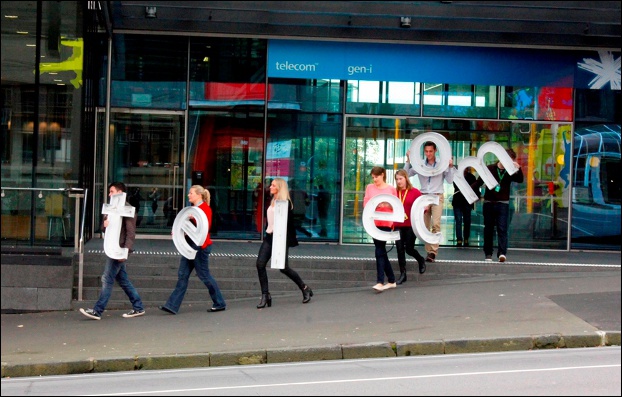Igniting the Spark – Why Telecom Wanted To Change
by Peter Kerr and Bill Bennett for Scoop Amplifier When an iconic New
Zealand brand such as Telecom decides it needs to change its
name, it has to be supposed it has pretty good reasons for
doing so.
When an iconic New
Zealand brand such as Telecom decides it needs to change its
name, it has to be supposed it has pretty good reasons for
doing so.
In a series of three feature articles to be published over the next week Scoop Amplifier will explore:
• What is the purpose of rebranding and
repositioning as Spark New Zealand?
• How does a major
New Zealand business go about reinventing itself?
• Why
does it matter for New Zealand?
As a globally isolated country, digital connectedness can erase much of the tyranny of distance for New Zealand as a trading nation. The new Spark contends that its success and New Zealand's future will go hand in hand. Scoop Amplifier, and its writers Bill Bennett and Peter Kerr examine how true this might be.
Contents - Igniting The Spark - Part 1 :
How a brand behaves is more persuasive than what it says
Telcos run into turbulence
Higher customer demands meet declining industry revenue
Telecom splits itself in two
What is Spark, the facts and figures?
Telecom puts itself on the examination table
Developing insights to understand Telecom's growth inhibitors
How Spark New Zealand came into being
Declaration: This content series was commissioned by Spark New Zealand Ltd. A strict protocol for the purposes of editorial freedom was agreed. The series was edited by Scoop Editor Alastair Thompson. Scoop Amplifier is a business unit of Scoop Media. Please send feedback to amplifier@scoop.co.nz
 Letters of the Telecom
sign from the Auckland HQ leaving the building to make way
for the rebrand
Letters of the Telecom
sign from the Auckland HQ leaving the building to make way
for the rebrandHow a brand behaves is more persuasive than what it says
The mobile and digital revolution is rapidly changing how we interact with companies and brands. If a smartphone is regarded as a weapon of personal empowerment, as Kit Yarrow [*] explains in a recent book, then organisations who don't change, do so at their own peril.
"Gone are the days of aspirational marketing when the brand was king and consumers flocked to own a piece of something they admired.
The consumer wants to be the star - and in a very personal way. The appreciated customer is one who's invited to participate.
Successful companies seek their customers' opinions...and reward their involvement. How a brand or retailer behaves or engages is more persuasive than what it says.”
* Kit Yarrow, author of 'Decoding the new consumer mind'. Published by Wiley, March 2014
Telcos run into turbulence
Revenues flatline as government regulation brings massive change at the same time as new players enter a crowded market
Telecommunications services are in demand as never before. Business and residential customers have an insatiable appetite for data whether it is delivered by copper, fibre or through the air. Traffic volumes are growing at a healthy clip and it seems as if everyone now has a smartphone.
Yet despite all this New Zealand’s telecommunications sector revenues are essentially flat.
According to IDC Research, in the three years to 2013, the market grew by just 0.2 percent. The research company’s analysts forecast a small decline over the next four years. There’s little sign of that changing in the immediate future. It’s important to remember the industry isn’t in decline, it is in transition from one set of business models to another. And while that can mean new opportunities, it also means adjustment.
Telecommunications revenues are flat because although people are buying more, prices for basic services are falling. This is partly explained by increased competition — what were once monopolies or duopolies are now open markets, in some cases crowded markets. It is also explained by the inexorable decline in some legacy services that fewer and fewer people use, such as the humble home telephone line.
Government regulation has also affected the industry widely, including the separation of Telecom’s old copper network, setting the prices telecommunications companies can charge and regulating the prices that the wholesaler Chorus can charge ISPs. Three years ago the Commerce Commission forced carriers to cut mobile termination rates. That’s the money they charge each other, and eventually the customer, when connecting calls from other networks. The Commerce Commission also recently cut the price service providers pay to access broadband networks.
Not all the threats facing telecommunications come from inside the industry or from governments. The arrival of smartphones opened the door to a new class of rival: the over-the-top (OTT) service providers.
OTT providers tempt customers away from voice or text services with apps offering free or almost free messaging and voice-over-internet-protocol (VoIP) calls that ‘ride over the top’ of existing – and expensive - network infrastructure. While telecommunications companies earn some revenue from selling the data used by OTT services, the margins are minimal compared with the services being replaced.
These competitors include companies like Google, Apple and Microsoft with products like Google Chat, FaceTime, Skype and Lync that all compete directly with traditional telecommunications products. There are also services like Facebook and Twitter which offer new communication formats. It should also be noted that many of these companies seek to reduce their tax burden in New Zealand or pay no tax at all here.
This threat leads to the industry fear of becoming little more than just a seller of undifferentiated data at low margins — in the trade this is known as the "dumb pipes" scenario. There’s a danger of being little more than a utility offering the same service as others with little room to add value.

A Telecom billboard in downtown Auckland
Higher customer demands meet declining industry revenue
Digital consumers have grown giddy on the notion that they can get more for less
Despite falling prices, flat revenues and external threats, telecommunications technology marches on and that means continuing demands for fresh capital investment. It means huge demands.
Take the move from third generation (3G) to fourth generation (4G) mobile. Earlier this year New Zealand’s mobile carriers collectively paid almost NZ$260 million to buy the 700 MHz spectrum flagged for 4G mobile. They’ll spend far more building cell towers and installing the hardware to run those networks. Spark New Zealand has committed NZ$158 million to secure the biggest share of the spectrum.
The industry big picture has been described as a clash of the unstoppable force — increasing bandwidth needs and the investment needed to support and maintain them on the one hand is meeting the immovable object of flat to declining revenue.
One way out of this pincer movement on profits is to look away from traditional telecommunications markets at tangential areas where margins are higher and there are more opportunities to innovate. Spark New Zealand started down this path a decade ago with the 2004 purchase of Gen-i and Computerland. Spark Digital (Telecom’s old Gen-i division) is New Zealand’s largest information technology service provider and adds considerable value to the parent company. More recently Spark Digital acquired cloud specialist Revera opening up fresh opportunities in a growth market.
An alternative strategy is to bulk-up by acquiring smaller telecommunications players and spread costs across a wider number of customers and product lines. Perhaps the biggest recent example of this was when Vodafone’s New Zealand operation paid NZ$840 million to buy TelstraClear in 2012. At the time of the acquisition the Commerce Commission noted there was little overlap between the two businesses. Combined under the Vodafone brand, the company now challenges Spark New Zealand in almost every market sector — the first sizeable threat across all industry sectors since Telecom was first privatised.
More recently CallPlus picked up Orcon thus securing its place as New Zealand’s third largest telecommunications business.
The industry turbulence that allowed Vodafone and CallPlus to expand also had an impact on the old Telecom. When the government decided to build a fibre network serving the 75 percent of New Zealanders living in cities and towns it specified that the network would be wholesale only. At first sight that meant telecommunications retailers like Telecom may have been shut out of the UltraFast Broadband (UFB) project.
Telecom splits itself in two
By taking the 'least worst option' Telecom quits being vertically integrated; and gears itself for life post-monopoly

Chorus and the now old Telecom logos
Faced with the option of competing against a government sponsored network, Telecom separated into two. At the time this was described as the corporation’s ‘least worst option’. The alternative would have meant defending an ageing copper network against a spanking new government-subsidised fibre competitor.
The Chorus demerger was an enormous step and unusual for telecommunications markets around the world. For most of its existence, Telecom was a vertically integrated telecommunication business. In other words the company owned almost the entire value chain: the company sold voice calls and internet services but also owned the networks transporting the services.
Vertical integration usually means greater operational efficiencies and reduced operating costs. That’s good for incumbent telecommunications carriers, but building a vertically integrated business is expensive and can only be done over a long time.
However, vertical integration and monopolies don’t deliver all the benefits of an open market. It is almost impossible for competitors to build new networks from scratch and incumbents have little incentives to share the benefits of the investments they have made in infrastructure. Telecom’s vertical integration was already eroding. Earlier government regulators had stepped in and separated the Chorus division from Telecom.
Today’s Spark New Zealand is a long way from the Telecom of just a few years ago. The business is no longer vertically integrated, instead it is a customer focused retail operation. Almost all the regulated parts of the former business went to Chorus, freeing Spark to compete on a more level playing field with its rivals. The telecommunications industry turbulence isn’t likely to go away soon, but Spark’s management is confident the reconfigured business is now better placed to cope with the challenges.
What is Spark, the facts and figures?
Still big, but more nimble, a reinvented company that is less hobbled by government regulation focuses on delivering value to customers

2013 Telecom annual report
New Zealand led the world when Chorus demerged from Telecom. It gave us a telecommunications industry structure where the network is completely separated from the products and services it delivers. The changes brought about a new market dynamic and it dramatically changed Telecom’s role.
On one level Spark is still like Telecom; a collection of related businesses spanning telecommunications, information technology and digital services. The company still operates state-of-the-art fixed-line and mobile phone networks. It remains New Zealand’s largest internet service provider and continues to be the nation’s largest information technology organisation.
And yet there’s a huge difference. Spark is nimbler than Telecom. Separating the services from the network means less dealing with government regulation and increased freedom to focus on delivering value to customers.
It remains one of New Zealand’s largest businesses. Last year the business turned over more than NZ$4 billion. As at December 2013 it had 1.9 million mobile connections, a million fixed line customers, 660,000 broadband connections and 2,800 businesses use its information technology expertise.
Telecommunications is evolving. Fixed line calling volumes and revenues are in long-term decline worldwide. The same trend is in New Zealand, but thanks to unmetered local calling being bundled into line rental the numbers here are falling at a slower rate.
Broadband continues to grow, albeit slowly as the market reaches saturation. Spark has roughly half of all NZ broadband customers and is holding its market share. The next challenge is to maintain this as New Zealand moves from copper to fibre delivered internet services. Rising demand for data on the move means the mobile market is growing.
Spark Digital, formerly Gen-i, remains New Zealand’s largest information technology company. It’s not unusual for a telecommunications company to own an IT business, but it’s rare for a telco-owned tech company to be a national leader. In many respects Spark New Zealand has achieved what other telecommunications companies around the world dream of: combining communications with high value-added information technology and digital services. This is also a pointer to where Spark New Zealand could head in the future.
Telecom puts itself on the examination table
An organisation takes a close look at itself and what its customers want as it learns to operate in a brave new world

Jason Paris - Spark GM Home, Mobile & Business
Becoming Spark New Zealand is the icing on the cake of a much deeper examination that Telecom carried out on itself.
A couple of years ago, Managing Director Simon Moutter introduced a 'Walking Back Slowly' initiative. The essence of this was that Telecom maintained some of its value-added services, while also adding other competitively positioned products.
This had an immediate positive effect on Telecom's bottom line and got the company back to growth – which hadn't been a major feature of the past few years.
“We learned that if Telecom became a competitor on pricing, we could clean up in the market,” says Jason Paris, Spark GM Home, Mobile & Business.
“The reason for this is we have better people than others in sales, marketing and experience. When you take price out of the conversation, and are within cooey in value, then we were able to get greater market share.”
However, when looking at the markets Telecom was winning in there were two glaring holes – Auckland and the under-35 market.
“These are the future super-consumers, the people who in the future will have a higher disposable income,” says Paris.
As a result, Telecom carried out a bunch of new, customer-focused initiatives. Most of these were inspired by the clear picture that for the majority of New Zealanders, data and mobility was becoming increasingly more important as well as over-the-top services such as digital music.
“So systematically we launched a number of new things that were unlike anything seen before in Telecom,” says Paris.
“Who would've thought that Telecom would have partnered up with Spotify, that we would transform telephone boxes into wifi hotspots that young people aggregate around when they're on holiday, that we'd provide free 4G and faster connectivity at the same price or introduce a $19 pre-paid mobile plan?”
Telecom also launched 29 local business hubs around the country.
These came about after business customers queried why, having signed up at a local level, they'd then have their own questions answered out of a call centre located in Auckland where “they were just a number”.
“It's important that we understand the local market, that we're in the game on value and have more to offer,” says Paris.
As well as introducing these new products, Telecom had conversations with its own frontline staff, its competitor’s customers and its own customers about what they thought about everything the company was doing.
“Our existing customers were impressed with what we were up to, and of course wanted us to be price competitive while acknowledging the improvement in service,” says Paris.
“Our staff too were much more confident in the brand, product and services, and our conversion rates were going up significantly.
“But our competitors' customers, in the main, had no idea what we were doing.
“Our conversations with younger Aucklanders and others under 35 showed that they thought Telecom was about old, rich and white people or that it was a business brand, or about a fixed line and home phone brand.
“It wasn't a brand about data or wifi or a deal done with Spotify.
“They were dismissing Telecom because of historical brand beliefs of what the brand had to offer.”
However, by the time of a brand refresh in October 2013, some early signs of success were emerging.
Foot traffic and conversion rates in Auckland were beginning to lift, and the brand preference was also shifting.
Off the back of this momentum, Managing Director Simon Moutter and Telecom Retail Chief Executive Chris Quin asked what could be done to accelerate the developments even faster.
Developing insights to understand Telecom's growth inhibitors
Revealing some like it or not truths about itself helps provides core strategies to move forward
Telecom's underlying inhibitors
Telecom's research
showed that there were five key inhibitors in peoples' minds
about the old company.
- You don't have any relationship with me at all
- You don't value my business
- You are holding me and New Zealand back
- You make the basics so hard
- You are outdated
Ramping up its brand development kicked off with the formation of a small team in Telecom, who towards the end of 2013 “went back to basics,” says Jason Paris, Spark GM, Home, Mobile & Business.
“We asked ourselves, what's the most important things for New Zealanders, and what do we need to be best at.”
This involved conversations with staff and customers, qualitative and quantitative data, “and aggregating and distilling this to create five key insights.”
These five insights have internally within Spark been recognised as five key inhibitors.
The insights are:
1. Customers felt like Telecom didn't really know them, in spite of quite a lot of data being available. For staff too, this data and information was not readily accessible
2. Customers didn't feel valued. Sometimes they'd see offers made to new customers, but existing ones missed out.
3. Competitors' customers saw Telecom as out-dated. They questioned why it took Telecom so long to start selling the iPhone or bring Spotify. “They were quite harsh on us,” says Paris. “There was the expectation we should've done these things earlier, better.”
4. Telecom wasn't easy enough to deal with, especially digitally. This was especially when compared to banks or airlines where everything can be done digitally
5. Telecom is not a brand that is really resonating with me. This applied to both customers and competitors' customers, and especially in Auckland and for the under-35s
This understanding, a like it or not truth, has been the driver behind the outcomes Spark New Zealand is pursuing in its strategies.
How Spark New Zealand came into being
What will count are the experiences that customers get

Spark New Zealand’s new logo in one of its colours
Often the invention of a new name, or application of an older term to become a brand name, is a convoluted and protracted process.
It can take months, if not years while the exercise goes through an initial wide number of possibles that are then narrowed down to probables, which are then focus tested and eventually, gain the approval of senior management and the company board.
Considerations such as what attributes the brand should have, those components of the old brand to keep and those to throw away, as well as new characteristics it should carry all come into the mix.
'Spark's' birth was much less protracted.
When the former Telecom introduced a new logo in October 2009 it left it up to New Zealanders to interpret what it was.
Telecom's own research, particularly with its staff indicated that people liked it – it represented energy and momentum, was dynamic fresh and new says Jason Paris, Spark GM, Home, Mobile & Business.
“Internally, our staff were calling it Spark,” he says.
“Kevin Roberts, the Saatchi & Saatchi marketing guru who was on the Telecom board at the time and Simon Moutter liked that name too.”
It stuck.
“At the end of the day too, it is just a name,” says Paris.
“The name is not what's going to make us successful. What will are the experiences that our customers get. That's what will make the difference.”
And while the official launch of Spark is August 8, the announcement of the new brand in February 2014 was very deliberate he says.
Telecom had recently sold its Australian subsidiary AAPT, so it took the opportunity to tell shareholders where some of that sale money was going to be reinvested.
“At the same time, rebranding is such a big programme of work that involves all staff across the whole organisation, we felt it was the best option,” Paris says.
“You can't go, 'look, we've got this great secret project that we can't really tell you about, but we really need you to work with us on this'.
“It would've been nonsensical not to talk about it.”
Paris says it was unfortunate at the time that some people saw it merely as a name change, without understanding the detail behind it nor the overall strategy moving forward.
“At that time it wasn't seen in its wider context,” he says.
ENDS
In Part Two of "Igniting the Spark" we will look at how Telecom went about reinventing the company.




 Ian Powell: “I Can Confirm They Are Hypotheticals Drawn Largely From Anecdotes And Issues The Minister Has Heard About.”
Ian Powell: “I Can Confirm They Are Hypotheticals Drawn Largely From Anecdotes And Issues The Minister Has Heard About.” Gordon Campbell: On NZ’s Silence Over Gaza, And Creeping Health Privatisation
Gordon Campbell: On NZ’s Silence Over Gaza, And Creeping Health Privatisation Richard S. Ehrlich: Pakistan & China Down 6 Indian Warplanes
Richard S. Ehrlich: Pakistan & China Down 6 Indian Warplanes Keith Rankin: War In Sudan
Keith Rankin: War In Sudan Ramzy Baroud: Netanyahu's Endgame - Isolation And The Shattered Illusion Of Power
Ramzy Baroud: Netanyahu's Endgame - Isolation And The Shattered Illusion Of Power Jeremy Rose: Starvation Of Gaza A Continuation Of A Decades-old Plan
Jeremy Rose: Starvation Of Gaza A Continuation Of A Decades-old Plan